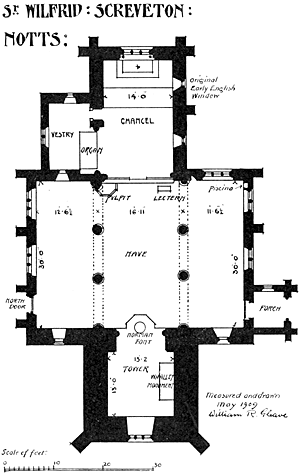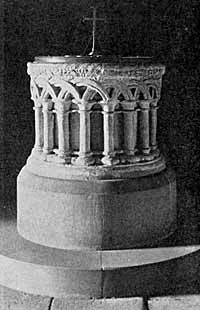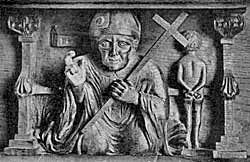Screveton Church
By Rev. J. Standish.

In his additions to Thoroton, in 1790, John Throsby speaks of this church as dedicated to St. Winifred. This dedication would be unique in the diocese. I take St. Winifred to be a mistake for St. Wilfrid. St. Winifred is a British saint of the 7th century, whose life and legend are intimately connected with Holywell, in Flintshire. While St. Winifred is not in any way connected with Nottinghamshire, the intimate association of St. Wilfrid with this county may be gathered from the number of churches dedicated to him. These are Kelham, Calverton, Kingston-on-Soar, Kirkby-in-Ashfield, Marnham, North Muskham, South Muskham, Scrooby, Wilford, and Screveton. Throsby no doubt obtained his information from Ecton’s Thesaurus. Pre-Reformation wills kept at York give St. Wilfrid.1
History explains the frequency of these dedications in Nottinghamshire. In 664 Wilfrid took a prominent part in the conference at Whitby, and was afterwards nominated to the See of York. He was contemporary with Theodore of Canterbury, and was brought, more than once, into unpleasant relations with that great primate. This led to Wilfrid being kept, at different times, out of his See of York; but he was a man of immense energy, and during these periods twice visited Mercia, doing great missionary work and founding many religious houses. He died at Oundle in Northamptonshire, in the year 709, having been one of the most remarkable of English churchmen, and a man of wonderful activity, great resources, and conspicuous talents. Dr. Bright tells us that with the death of Wilfrid closed a great period,” and the period which succeeded was altogether inferior and adorned by less splendid names.
There is one other point respecting this dedication. Screveton Feast Day falls on the Sunday before St. Luke’s Day, the 18th of October. On this reckoning, the Feast Day cannot be earlier than the 11th, nor later than the 17th October. St. Wilfrid’s Day falls between these dates, namely on October 12th; on the other hand St. Winifred’s Day is on the 3rd November.
Going briefly through the architecture of the church, you will find the oldest parts to be these:—the arch on the north side of the chancel, the easternmost lancet window on the south side of the chancel, the beautiful font under the tower, and the north arcade.
The arch, on the north side of the chancel, is of two orders of chamfers, so obtusely pointed as to be almost semicircular, the pillars have the plain pointed bowtell moulding, and the capitals have square abaci.
The two lancet windows, on the south side of the chancel, are without any label mould, and the eastern one, untouched by later hands, must be a very early window of its kind. The respond at the east end of the south arcade has the cap and abacus mould carried round a square pier; but this seems to be a restoration error. A somewhat similar idea has been carried out on the respond at the east end of the north arcade.

Font, Screveton Church.
The font is specially interesting. It possesses a beautiful arcade of intersecting arches, with pillars that are practically disengaged from the body of the font. Above the arcade, the rim of the font is adorned with leaf work and a continuous piece of cable work, one strand of which is enriched with the nail-head ornament. The arcading runs closer on the western side, and indicates that the mason has worked without any plan or any preliminary striking, out of his design. At the ends of a diameter of the font, running north and south, it should be noticed that the font has been repaired by two pieces of new Roche stone, given by Lord Scarbrough to the present rector. Apparently the font has possessed a lid, with hinge at one side and hasp at the other.
Now what is the date of this font? About 1170 is the date generally given, and it is spoken of as transitional Norman. But Rickman gives the date as 1140 for the Ancaster font, and 1150 for the date of similar arcading at Kelso, Scotland, We have examples of this arcading at Southwell, Peterborough, Croyland, Lincoln, etc., not to mention a ruder form of it at Stanton-on-the-Wolds. The text books regard this arcading as Norman, where it is not combined with the lancet arch. There is similar arcade work, semicircular and intersecting, on the west front of Lincoln Minster, the date of which lies within well-known limits. It may be as early as 1123, and cannot be later than 1147. On these grounds I am inclined to think that this Screveton font may well be from thirty to forty years older than it is generally said to be.
The aisles of the nave have been rebuilt and their walls lowered, but judging from the windows, which have been re-inserted, the north aisle comes next in date after the chancel and the nave arcades. Its two three-light windows, with intersecting mullions, belong to the earlier half of the 14th century, and are very early Decorated work. The windows at the east and west ends of the north aisle have the hollow chamfer, and are probably of the early Decorated period.
The arcades of the nave are Early English work. The bases on the north side have a very early three-roll mould, and one on the south side the later water-mould. The two square-headed windows of two lights each belong to the late Decorated period, and are possibly fifty years later in date than the arcades (i.e., circa 1380). There is half a similar window at the west end of the south aisle, and at the east end, a still later insertion in the shape of a small Perpendicular window of three lights. Between the latter and the adjoining window of the south aisle, a piscina was discovered during a restoration in the year 1884. The name of the chapel which it implies is not known. Its basin is ornamented with a conventional lily, of which the petals are disposed in a circle. It is late Decorated work, I think, contemporary with the square-headed windows.

Misericord, Screveton Church.
In the first volume of our Transactions, the writer on this church says “ the tower was the last addition, late in the sixteenth century.” I cannot reconcile myself to this statement, as the square-headed west window of three lights, and the diagonal buttresses, and the moulding of the string courses are marks of the Decorated period. The string moulding is also found in Early English work.
The present fittings of the church are all modern, though the bench-ends in the choir have been modelled on older work. The priest’s stall, on the north side of the chancel, has an old miserere seat built into it, worthy of inspection.
(1) See Godfrey’s “Bingham Churches,” pages 387 and vii.
